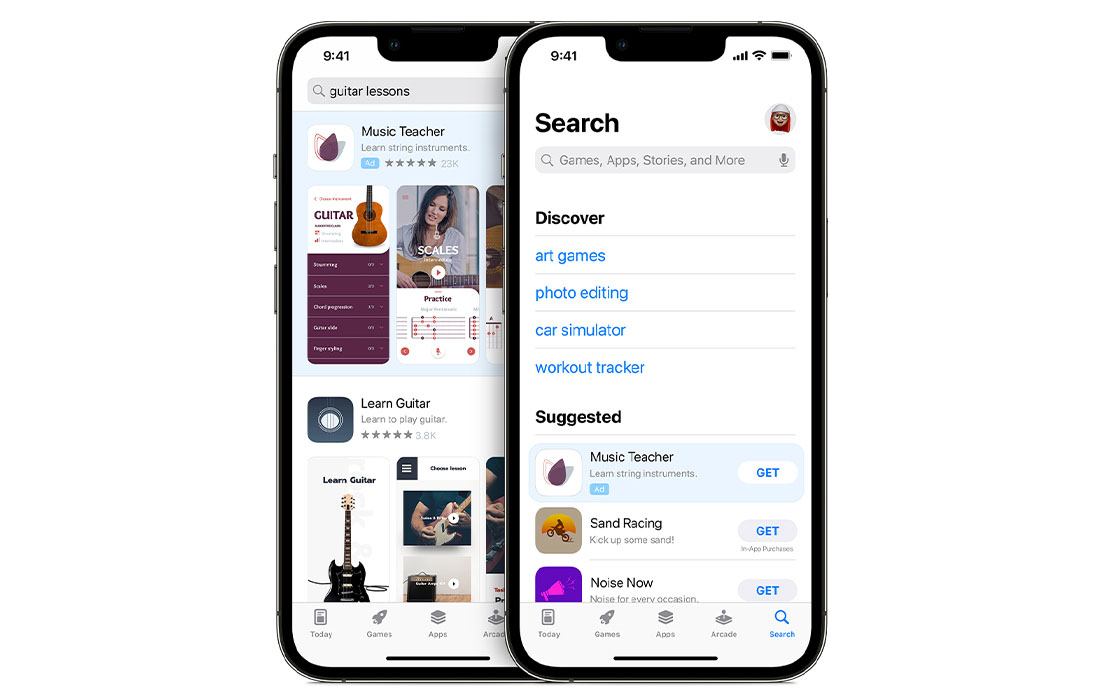Apple is set to introduce two new ad placements on the App Store, providing developers with more opportunities to promote their apps and attract users.
For users and advertisers, what do these new ad placements signify?
Introducing Apple's New Ads Placements on the App Store
One aspect of Android that users find bothersome is the abundance of ads. These ads can easily be triggered by accidental taps on screens or search bars, resulting in automatic downloads of various software. In contrast, Apple's system has always been praised for its clean, smooth, and ad-free experience. Currently, the Apple App Store features two ad spaces: one in the search tab and another in the search results.
However, it has been reported that Apple will soon be testing
two additional ad positions on the App Store. These new placements include an ad space on the
App Store Today page and one in the
You Might Also Like section of an app's product page. To distinguish them from organic recommendations, these ads will be clearly labeled as advertisements.
So why are mobile phone manufacturers eager to incorporate advertising space into their devices? The answer is simple: profit. Android manufacturers have been reluctant to let go of advertising because of the substantial revenue it generates. Apple, on the other hand, has a different approach. While it only offers advertising services within the built-in App Store, it still generates significant profit. Analysts predict that Apple's advertising and promotion business, particularly search ads, will bring in at least $6 billion in profit by 2025.
Apple's Commitment to Transparency and Privacy
Apple states that its new ad placements align with its emphasis on transparency and privacy. The company avoids hyper-targeting specific users or niche groups and does not display tailored ads to individuals under 18 years old. Additionally, Apple never serves ads using sensitive data such as political or religious information. These policies ensure that Apple Search Ads practitioners can identify potential clients while maintaining user privacy and trust.
Implications for Mobile App Advertisers
While Apple tightens its privacy policy, the introduction of new ad display spaces presents new opportunities for mobile app advertisers. How can we seize these opportunities to precisely target our customers?
Tactics for Apple Search Ads Targeting
One of the intriguing features of Apple Search Ads Advanced is Search Match. This tool allows advertisers to launch campaigns quickly by automatically targeting ads based on search terms. Search Match analyzes relevant advertising and provides suggestions, saving advertisers time and effort in creating keyword lists. It utilizes metadata from the app store page and other apps in the same category to generate these suggestions.
While Search Match simplifies ad targeting, keywords remain essential for an effective App Store advertising strategy. Apple Search Ads allows advertisers to place keyword bids and provides additional tools for keyword targeting. The default setting is "wide match," which broadens the targeting by running ads on variations of keywords. For precise targeting, advertisers can choose the "precise match" option and select specific keywords and variations to include or exclude using negative keyword matching.
Another valuable feature of Apple Search Ads targeting is the ability to reach specific audience segments based on their previous interactions with the app. Advertisers can target all App Store users, new users, returning users, or users who have previously used other apps from the same developer. By tailoring ads to these different customer types, advertisers can improve their advertising ROI.
Appropriate targeting is crucial for advertising success, and Apple Search Ads offers demographic targeting options by age and gender. Understanding the target audience and using demographic targeting can greatly enhance ad effectiveness. However, it's important to note that ads are not shown to users under 13 years old, and there are additional age restrictions in different regions.
Targeting audiences by device type is another valuable feature of Apple Search Ads. Advertisers have the flexibility to adjust bids based on device type or customize audience criteria specific to certain devices. For example, if an app works on all platforms but performs better on iPhones, advertisers can modify their bids accordingly.
Location plays a crucial role in many apps, and Apple Search Ads allows for region-specific targeting. Advertisers can deliver location-based ads to users near specific areas or businesses. Understanding the audience, product, and using precise targeting practices are essential for maximizing the effectiveness of Apple Search Ads.
Conclusion
With the introduction of new ad placements, Apple is aligning itself with other software stores by offering more advertising opportunities. By applying the targeting strategies mentioned above, advertisers can efficiently locate and reach their target audience on Apple's platform.
Now just join
FoxData and embark on a journey of business growth as we unveil a FREE App Data Analytics Tool, which boosts your downloads, increases your user base, and watches your performance soar to new heights!
💡If you're seeking a professional team to achieve success, don't hesitate to contact us for
ASA service.
All content, layout and frame code of all FoxData blog sections belong to the original content and technical team, all reproduction and references need to indicate the source and link in the obvious position, otherwise legal responsibility will be pursued.



